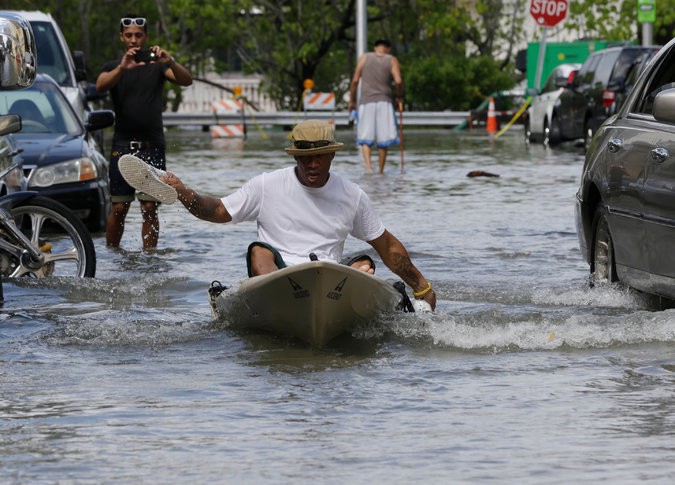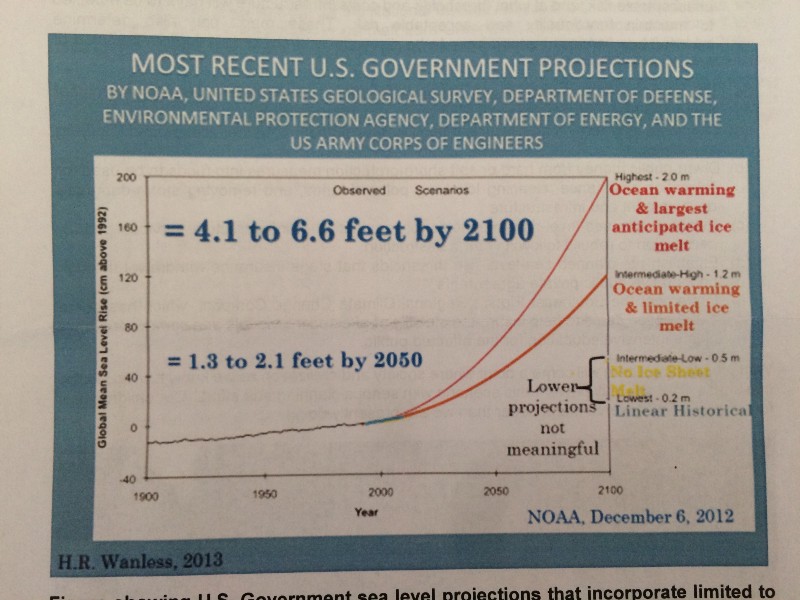Charles Waldheim at Harvard’s Office for Urbanization was kind enough to invite me to give the closing remarks at a meeting yesterday of designers, architects, city planners and municipal leaders at Miami Beach on the topic of Miami Beach and sea level rise. It’s a great place to have this conversation, partly because the city is already feeling the effects of sea level rise, but also because there’s a massive building boom happening right as the city is starting to experience an unprecedented level of regular flooding.

Miami Beach is also starting to become a place that people are looking at to see how these two trends—massive investment in cities and sea level rise—are playing out. Recent articles in the New York Times and Vanity Fair are drawing attention to the unique (for now) challenges that the city is facing, as a canary in the coal mine for what could be a new reality for cities all over the world.
How can these two huge, concurrent phenomena, seemingly at odds, be reconciled?
“They can’t be. The developers, [Harold Wanless] said, are “building like there’s no tomorrow — and they’re right!”
Before going to the meeting, just to be prepared, I took a look at what our Climate Central maps show for even just a few feet of sea level rise, and well. It’s not good:
What follows are my off the cuff remarks at the conclusion of a fascinating discussion.
I’ve been asked to provide some remarks in conclusion. They’re not particularly connected, since I wrote them while you were all presenting. I hope you’ll indulge me! Usually I just show climate change porn. Thank you for inviting me and I’m tremendously excited to have the opportunity to be part of this conversation. It may be the most important conversation there is.
When I first started thinking about this colloquium, the main thing I was excited about was this idea that sea level rise, here, is happening at a very specific intersection of a committed populace and lots of capital. That you have here a kind of unique condition where designers and planners have the ability to deal with sea level rise in kind of an exciting way. I even read about it in Vanity Fair! I still think that’s unique and exciting but I also want to respond to what I’ve heard here today.
Does anyone else have the feeling that everything that we’ve said here or that I could say or do is table stakes given what Harold Wanless said at the beginning of this colloquium? That no matter what we do, we’re locked into levels of sea level rise of tens of feet by the end of the century?
I love a good floating house as much as the next guy. I think that reclaiming an industrial waterfront for public use because the ocean is flowing in is a fabulous idea. We’re doing it in San Francisco where I live, it’s happening in New York where I’m from. Technology is advancing at an incredible degree, and it feels like we’ve got all kinds of opportunities just around the corner. I have a special soft spot in my heart for breaking the permeable layer of the city and letting the rain soak into the ground. Materials are getting completely fascinating. But 15–30 feet of sea level rise? by the end of the century? with more to come after that? a foot a decade? And even faster? All the curve lines Harold presented trend up.
I learned today about “rapidly accelerating ice melt.” 93% of the heat that has accumulated on the earth since the 1970s is stored in the sea, and only 3% of this in the atmosphere. Most of the models don’t account for accelerating ice melt. The Antarctic and Greenland ice sheet isn’t just melting on top, it could literally slip off the land and into the water basically all at once.

I think I understand what Harold said, and it’s scared the crap out of me.
I don’t know what to think about this. But maybe it’s important, at a place like this, to acknowledge being scared. Susanne Torriente talked about how one of the 100 Resilient Cities’ principles of a resilient city is to pause and be reflective. I want to do that based on what I learned here today.
We talk about a goal, that a goal of this work is to find ways to meet a goal of resilience, a goal of sustainable and equitable urban living. And I think it’s important to think about what it means to have a goal.
When we talk about a goal, typically it’s ok if you get about 90% of the way there. You shoot to raise $100k, you raise $90k, that’s all right. This is something my coach Michael Cooper taught me. When you make a goal, it’s OK if you’re a little bit short when you’re done.
On the other hand, when you talk about a floor, you typically overshoot by a bit. You say you need to raise a minimum of $100k, it’s pretty likely you’ll raise $110k or $120k. I want to think about what’s the floor. What is the minimum response?
Is it possible to overshoot this goal, or floor? Because we’re human, when we respond to sea level rise, we’re going to see closed door meetings, back door machinations. I think it’s very interesting and indeed heartening to think about regulations, and I’ve heard people here talk about how Miami Beach is setting up regulations and incentives for property owners, and that’s terrific. But I think as designers and architects it’s also important to think about power and the exercise of power. I’ve been looking at the tax code for a while in my work at CAST, and if you look at for even ten minutes you can see very clearly that it was written by property owners. So there are power dynamics at play here, and if we ignore them and think that all of this is just going to happen in the open via democratic processes, we’re missing a big part of the picture.
Who’s going to be the Robert Moses of sea level rise? Who is going to be the person who actually goes too far, raises sidewalks in the middle of the night when no one is looking, makes a city too resilient? Is that even possible?
What’s the sea level rise equivalent story of the bridges over Long Island highways, where they’re too short for buses? Cause that’s going to happen somewhere. The response isn’t going to be the same everywhere. What if the poor get similarly shut out somehow of a bright green future, at the expense of a green stable planet full of resilient cities? I learned from Jesse Keenan at CURE about Climate Gentrification today. I hadn’t thought about it before, but it’s a thing: highly resilient and climate-adapted neighborhoods are starting to see the same kinds of hyper inflated property values we’re seeing in the Mission District, where I work in San Francisco, because of its proximity to Google bus stops.
Is that entirely a bad thing? I’m not sure, but I do think it’s a mistake to think that all of this important and vital work to address sea level rise is going to be done by well-meaning people or the public sector.
I’m starting to think about sea level rise in terms of culture, not just science, or policy. I’ve been down the road where we visualize the data and make a map and put it on the internet or show it at a conference and then expect things to change in the world. And that’s just not how things really work.
I’m a map maker and a data visualizer and a communicator in public. So I think about how to make things visible. There are a lot of lenses to look at what we’ve heard here today. I look at what I’ve heard today through this very particular lenses.
How bad is it? I think this hasn’t been communicated nearly well enough. I think we need a really focused effort to understand what’s going to happen, what’s locked in, that’s more than nice clean water in the streets of Miami Beach, as compelling as that is. We need more than maps. I don’t know what we need. But I know I want to see, and maybe make, images that scare everyone else as much as Harold scared me this morning.
How good could this be? I don’t think that’s been communicated well enough. This gets back to the Robert Moses part. The economic upside of sea level rise should be a thing we’re really thinking about. What is the Harvard University of Sea Level Rise, where we send our best students to work on this full time? What’s the Silicon Valley of sea Level rise? Who’s the Mark Zuckerberg? Who’s the Elon Musk of sea level rise? There should be Sea Level rise Russian oligarchs who make fortunes moving cities or whatever it is we’re going to do. I think there will be. Some of them may well be our patrons. I think that’s coming and I think our profession needs to start getting used to that idea.
Thank you.

